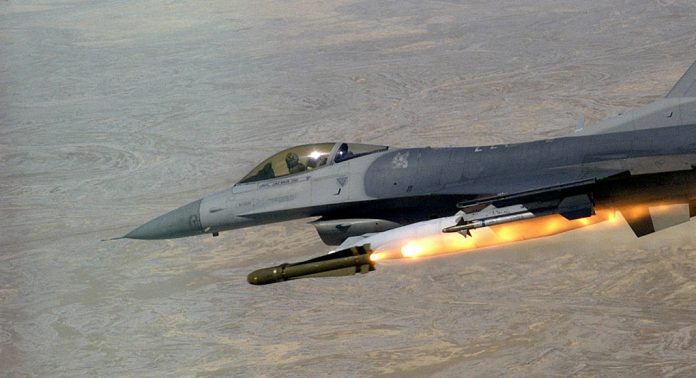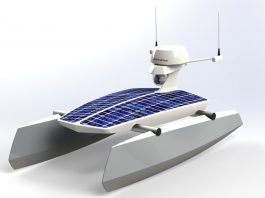Nordic Radar Solutions outlines the ABISS – a radar system that delivers high quality, near real-time weapons scoring data to military customers when operating in extremely demanding environments.
Regardless of platform, there is always limited time and budget to train and refine the delivery of weapons. The time spent should therefore be as informative and automated as possible. Having information readily available and delivered in real time allows the pilot to orient their attention towards decision making and acting faster. Currently, however, weapon scoring is very costly and time consuming. Nevertheless, new technology developed by Nordic Radar Solutions looks to provide an answer for these problems.
“Today, weapon scoring is being performed with excessive human interaction on the ground. Visual identification of impact area, estimation of impact effect, calculating angle of approach, counting fragmentation and analysing probability of kill – these are just a few of the time-consuming tasks which could be automated,” Per Schmock, CEO of Nordic Radar Solutions, explained.
As a former military pilot himself, he knows only too well that the pilot is subject to long waiting times either in the air, using valuable time, or forced to land and wait for results in order to receive feedback and try again.
That was why he and Nordic Radar Solutions set out to develop an advanced radar solution that would enable the fast and objective analysis of the weapon delivery and enable the pilot and on-ground personnel to enhance their training patterns. The Advanced Battlefield Integrated Scoring System (ABISS) has been developed for the specific task of improving weapons scoring in close collaboration with the Royal Danish Airforce. It is a cost-effective multipurpose detection system which assures live and extremely accurate scoring data.
Current radar systems are often outdated
System complexity and requirements to mission operations are the two main reasons why weapon scoring systems have been used insufficiently and with limited effect. The desire to run complex missions with accurate scoring data has historically required very complex systems, resulting in great cost in terms of both operators and equipment. The legacy systems currently installed at weapon scoring ranges throughout the world are often outdated and do not match the weapons or weapon delivery platform.
Delivery systems and weapons are constantly improved and advanced, however the data collecting equipment supporting their development, and which enable this development to be speeded up and which, in the end, result in more accurate systems in the end, are often neglected.
The complexity of the system required to run advanced missions involves people stationed at several positions, all of whom are educated on different systems in order to collect sufficient data. Furthermore, several ranges still operate on a manual basis, with visual spotters and manual documentation. In the process of collecting the data, the pilots are often required to enter holding positions in the air, or land and wait for results, resulting in added cost.
Learning from these things, Nordic Radar Solutions has derived two mission statements:
- The system needs to be able to operate complex missions with ease for the operator in real time and be able to export data in an easily read debrief format. It needs to support multiple simultaneous attacks, and also support multiple weapons and operation at night and in bad weather; and
- The price of the system and the amount of personnel required to run the systems need to decrease in order to be cost effective.
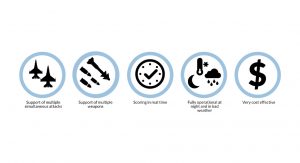
By understanding the problems and acknowledging the requirements, Nordic Radar Solutions has been able to develop and create a system which meets both the required standards and the operational patterns. This article highlights some of the operational benefits, operations and the cost effectiveness.
Concept of operations
For the purpose of this ‘light’ CONOPS, we will use the Danish Air Force proving range, located on the western shores of Denmark, in the North Sea.
The 2.228 acres of proving grounds is a vital component in the training of Danish Air Force pilots, Forward Air controllers, and sharp shooters. 75% of the area is sand beaches, dunes, and wetlands – making conventional instrumentation systems incapable of collecting precise data due to:
- Standoff range to impact area not far enough to protect data collection systems; and
- The systems are not sufficiently mobile.
The geography inhibits fast and objective data collection at a pace where pilots and other weapon delivery artifacts are not effectively used. The collection of data, association, and analysis needs to be automated and provided faster to the operators.
The Royal Danish Airforce approved the development of the Ka-band radar from Nordic Radar Solutions in 2016 in order to reduce operating cost and have a stand-alone multifunctional scoring system available across the entire geography of the site with great mobility.
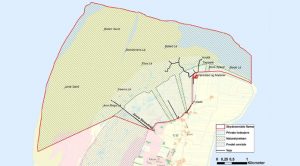
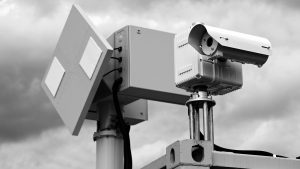
Objective
Reduce the waiting time for pilots and on-ground personnel, while improving the data collection, association, analysis, and feedback for the ground personnel. Highlighted below are a few examples of user scenarios.
Challenges for fixed wing aircraft
Both pilot and weapon platforms are subject to constant change. Less training flying hours are available as more sophisticated and costly aircraft platforms become inventory. The output is less effective pilot training in special types of munitions and weapons – ‘Physical testing is at a premium’. The scoring of live firing of all types of munition, in any terrain and condition, is currently not an option.

Challenges for Unmanned Aerial Systems (UAS)
UAS assets and strategy is an ever growing and important part of the landscape. The current UAS platforms, Future Combat Air Systems (FCAS), and drone swarms, will still and, in the future, be required to operate alongside fixed wing platforms.
New ways of collaboration will have to be practiced, explored, and refined to harmonise the best delivery of weapon effect.
Challenges for Forward Air Controllers/JTACs
JTACs who facilitate Close Air Support in direct support of ground units are often limited by the availability of fixed wing aircraft. Having the ability to ‘prove’ weapon accuracy faster can have a significant effect on their skills and Increase the number of training schemes within the designated time frame.
The following example will derive from the challenges for fixed wing aircraft, and why the Royal Danish Airforce are co-developing the solution with Nordic Radar Solutions.
The above diagram indicates the flow of data for the pilot and ground personnel. The waiting time, displayed in the middle, will be the subject of this whitepaper, as waiting for results in order to improve is the costliest part of training.
By utilising ABISS as an objective scoring system designed to support training for aviation gunnery, indirect fire missions, and other instrumented ballistic measurement, we will reduce the waiting time for all involved personnel.
Processes for initiating, developing and maintaining the system
The core of the ABISS is made up of an advanced Ka-band radar, which illuminates the selected target with multiple beams, thus being able to accurately measure the impact point, velocity, and angle of the incoming weapon in near real-time, during day and night and in all-weather.
The Ka-band technology
Ka-band is a shorter-range radar technology that uses extremely short pulses of just a few nanoseconds, providing unmatched range resolution when compared to conventional weapon scoring systems operating in other frequency bands, such as the x-band. The most important technological feature of the Ka-band is the capability to minimise clutter, enabling high precision despite an array of other artifacts in its area of interest.
The proposed system is superior in terms of the overall quality, level of detection, enhanced detection volume, and life expectancy than that of comparable systems.
The system takes instrumentation technology to the extreme, utilising key technological features in the Ka-band coupled with advanced filters and easy to use graphical user interfaces, which has been co-developed with the Royal Danish Airforce users.
Operating the system
Once initiated and armed, the system is ready to collect data from the airborne weapon platforms. The system operates on two basic parameters (target type and attack type), typically divided into small projectiles and large diameter weapons (bombs, missiles, etc.). The projectile setup handles calibres from five to 155mm at a rate of up to 6,000 rounds per minute. This enables the pilot, firing any secondary weapons, to receive instant feedback from the ground on accuracy, miss distance, spread, and burst length. The scoring delay (data collection, assembly and analysis) is available for feedback in approximately one second.
At a range of up to 16km, the system collects the data, assembles the information, and analyses it in near real-time. No human interaction on the ground near the target nor visual confirmation is required.
The cameras on the container record the impact for post-analysis and post-visual reporting but is not required in the feedback loop. Before the pilot exits the target zone, he will be able to receive the information from the ground, making the second engagement information and corrections available instantly.
The large diameter weapon setup handles large projectiles, with the purpose of scoring as mentioned above and collecting valuable information for fragmentation analysis. The information gathered could be information from the impact of missiles, such as airburst fragmentation time, altitude, and angle in order to improve programming of the missiles or bombs in air.
As a result of being able to record the information in near real-time and perform the analysis equally fast, the engagement of targets and the mission operation theatre change in training missions. Now, the training theatre will be able to provide more realistic training scenarios with multiple engagements. Attack helicopters, ships, fighter jets, and other weapons systems will be able to engage the same target with minimum delay and risk of collateral damage to each other, whilst collecting all of the data and providing instant feedback.
Reducing the time
As described above, the data collection, association, and analysis are one of the bottlenecks in training missions – reducing the time spent is crucial.
By utilising the features in ABISS, visual monitoring becomes unnecessary as the data collection, association, and analysis happens instantaneously and in near-real time. As the pilot banks away from the engagement, the ground operator will be able to provide the necessary feedback to the pilot, who will be able to engage the target a second time with corrections. Meanwhile, the operator will be able to guide indirect fire, or secondary engagements from attack helicopters, which will increase the complexity of the training scenario and increase the value of the training for all mission personnel, which is often in a joint context.

Increasing operational freedom
Training and the validation of target scoring is often restricted to the geography, as many systems are unable to relocate or be installed in remote locations with ease. Making the system fit inside a 20-inch container increases the operational freedom and flexibility to train anywhere for any mission.
The system can be airlifted to any location or placed on a barge and operated in a remote location at sea. This flexibility provides the possibility of target scoring in completely new mission scenarios, with new calibres and attack profiles, which in turn does not need to be modified to fit the geography or system constraints. The system created by Nordic Radar Solutions thus allows the pilot and others to perform realistic training missions.
Nordic Radar Solutions offers military heritage, developed for the Royal Danish Air Force, where we have been demonstrating outstanding performance and reliability. We are able to offer the following benefits:
- Train more and create more complex and joint training schemes to enhance the quality of training;
- Combine platforms and weapons engagement types;
- Train in remote locations due to the system’s small footprint and remote operability;
- Saving time – reducing cost – with restrained military budgets and increasing complexity and where effective and fast target scoring is essential; and
- A solution to where traditional methods in target scoring are no longer sufficient and there is a need to generate valid feed-back in real time.
Our technical uniqueness:
- Ka band radar with a wavelength of <1 cm, allows the detection of extremely small objects;
- High gain antennas allow for the detection of weak signals from small targets;
- Integration and sensor fusion – a complete blended information hub using a unique integration of sensors to provide final classification of targets;
- User-friendly interface – easy integration to airfield- or mobile systems such as lap-tops, tablets, or smart phones for fast, accurate, and reliable decision making and risk assessment;
- 4D polarimetric radars using vertical and horizontal beams to capture small or flat objects; and
- Realtime processing of signals to provide the instant detection of targets.
About Nordic Radar Solutions
Nordic Radar Solutions (NRS) focuses on developing next-generation advanced radar-based systems dedicated to civil aviation, wind energy installations, and target scoring applications requiring cost effective high accuracy detection and tracking against air and surface targets.
Our vision is to be the leading and most competitive radar business that improves investor value by being the preferred business customer, preferred employer, and preferred supplier of their products.
Per Schmock

(CEO and co-founder) – A pilot from the Royal Danish Air Force who advanced to become a Tactical Air Command Denmark Experimental Test Pilot on the F-16 Fighting Falcon. A pilot/test pilot with Scandinavian Airlines, then an experimental test pilot with Terma A/S. A strong commercial background and an MBA.
Torsten Elmkjaer

(CTO and co-founder) – M.Sc. In Antenna Theory and a Ph.D. in Active Noise Control, with 30 years of field experience in sensor system design and a specialist expert in radar systems, antennas, signal processing, tracking, control, microwaves, acoustics, and tracking system design (including sensor fusion).
Please note, this article will also appear in the sixth edition of our quarterly publication.

